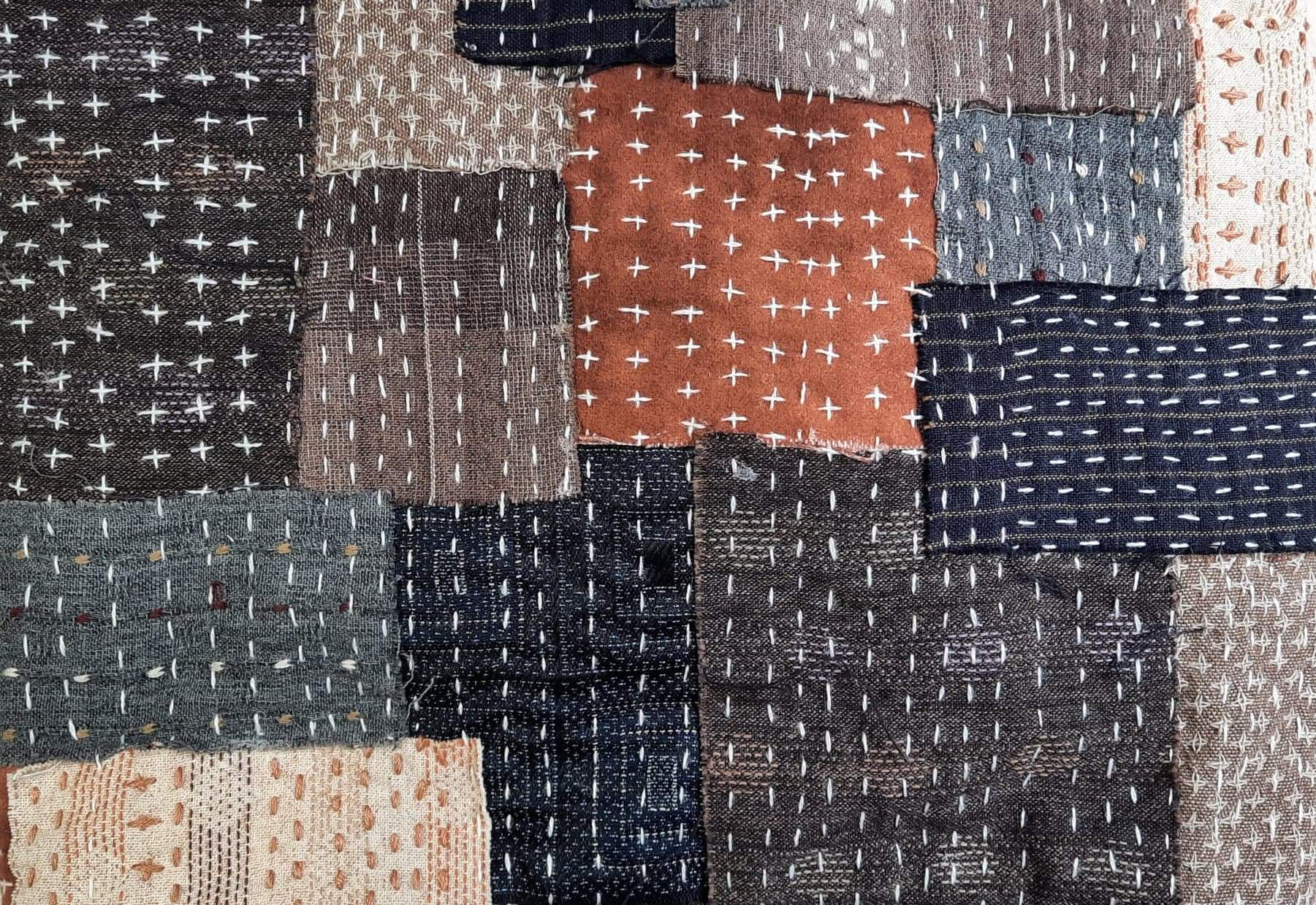
Difference Sashiko and Boro Sashiko Story Vol 2 Upcycle Stitches
Be playful and remember there is no such thing as making a mistake. If your thread is too thick try dividing it into two separate strands. Consider different textures of fabrics and threads. Consider different lengths and directions of threads. Think about how you can use stitch-free space as well to balance out a design.

Boro Inspired Sashiko Stitching YouTube
The effect of "loving" someone, including ourselves, is referred to as boro. Sashiko is a form of embroidery that uses white-on-indigo threadwork, while boro refers to the use of rags or tattered cloth. Sashiko stitching was born sometime in the Edo period (1615-1868) and was often used to repair and repurpose fabrics.

Boro Stitching Needles & Threads
The most common Japanese embroidery stitch is the running stitch, used in both Sashiko and Boro. Also used is the stem stitch and satin stitch. However, as seen in the Bunka stitch, you can mix the different techniques. 3 tips on how to do Japanese embroidery. Take Japanese embroidery classes.

japanese boro Google Search Boro stitching, Sashiko, Art quilts
However. Boro is not a word for patchworking. Boro is not a technique of mending. Boro represents the poverty in Japan, Shame and Pride. Boro isn't just about "worn" fabric. Boro carries a lot of stories, and the Japanese Culture. We are here to share. We make "To-Be-Authentic Boro" today to respect the Japanese.

Pin by Susie on Boro Textile art, Patchwork art, Sashiko embroidery
Boro is Japanese for 'rag'. Sashiko is the simple running stitch that holds the boro in place. As all things Japanese, words convey a more complex background. Style of the past. During the Edo period, it was a frugal time so every scrap of fabric was put to good use. The stitching was a way of strengthening and attaching the fabric to an.
sashiko and other stitching Edinburgh Exploring Japanese Boro
Hitomezashi might use sashiko thread, or the marginally heavier kogin sashiko thread for stitching so as to improve the 'plump grain of rice' impact of the stitches. Kogin (photograph under) stitching can also be a kind of sashiko. Once more it's stitched with the heavier kogin sashiko cotton thread to extend the 'fats rice grain.

Boro Inspired Patch With Sashiko Stitching Denim and Cotton Etsy
While some antique pieces include simple Sashiko, boro is not a style of Sashiko stitching. It is the embodiment of another currently popular Japanese term, mottainai "don't waste!" . The vintage boro is particular easy to do, it's a factor that people want to learn themselves and practice their self and so creating particularly former .

Boro stitching image by Tim on sashiko boro Sashiko, Upcycle clothes
Boro textiles are restored by overlapping and stitching spare or discharged scraps of fabric together, essentially using a sashiko stitch, to reinforce the material. Boro fabrics were typically indigo-dyed as it was the cheapest natural dye available, and a remarkable number of boro pieces also showcase kasuri dye work, a form of ikat dyeing.

Boro sashiko stitching project. Part 1 Japanese embroidery, Boro
Hitomezashi may use sashiko thread, or the slightly heavier kogin sashiko thread for stitching in order to increase the 'plump grain of rice' effect of the stitches. Kogin (photo below) stitching is also a type of sashiko. Again it is stitched with the heavier kogin sashiko cotton thread to increase the 'fat rice grain' effect of each stitch.

Boro and Sashiko Harmonious Imperfection {book review} the
The Shibaguyz share their love of boro & sashiko and about their brand new book, Boro & Sashiko, Harmonious ImperfectionAbout the book:30+ authentic stitch p.

hand stitched sashiko and Japanese boro inspired fiber art Japanese
Sashiko tends to come hand in hand with boro as it was one of the more reliable stitching techniques used for patching. For more in-depth insights on sashiko, check out 7 Things to Know About Japanese Embroidery. Shonai Boro. This type of boro finds its roots in the picturesque Shonai region of Yamagata Prefecture.

Difference Sashiko and Boro Sashiko Story Vol 2 Upcycle Stitches
While some practitioners take a freeform approach, the most pleasing stitches tend to be in the sashiko tradition.. Sashiko—frequently translated as "little stabs"—was born in Edo period Japan (1603-1868), when rural women attempted to prolong the life of their families' tattered garments and bedding, giving rise to a humble.

Japanese Boro Sashiko Slow Stitch mending patch Natural Indigo Full
By Mary Ray Threads #195, Feb./March 2018. The Japanese art of mending, called boro, is experiencing a resurgence. Originally, the quilting technique was applied to extend the life of ragged and tattered clothes and household items by sewing patches in place with sashiko, a simple running stitch. Typically sewn in a pattern of parallel lines.

Boro Inspired Sashiko Patchwork May 3rd Upcycle Stitches
My understanding is. Sashiko is a form of stitching, a process of needlework. The Boro is the result of continuous & ultimate repetition of Sashiko. In other words, Sashiko can be a verb in Japanese. We occasionally say that we "do Sashiko". In contrast, Boro doesn't become a verb in the Japanese language.

Japanese boro SashikoSlow stitch PatchHand sewn of recycled fabrics
Sashiko stitching made Boro pieces stronger and warmer. Today, Sashiko adds a gorgeous touch to textiles and remains a beautiful way to mend garments or create Boro-inspired pieces. FIN Crafted Goods is a sustainable lifestyle brand in Singapore that focuses on repairing and rebuilding garments. Influenced by Japanese culture and values, FIN.

Boro & Sashiko, Harmonious Imperfection The Art of Japanese Mending
Boro is a ultimate result of repetitive Sashiko stitchings over and over for many generations. The Japanese had to use the fabric even it gets tattered beyond the normal usage. They patched the fabric and stitched to make the fabric usable. Boro is merely a result of continuous stitching.